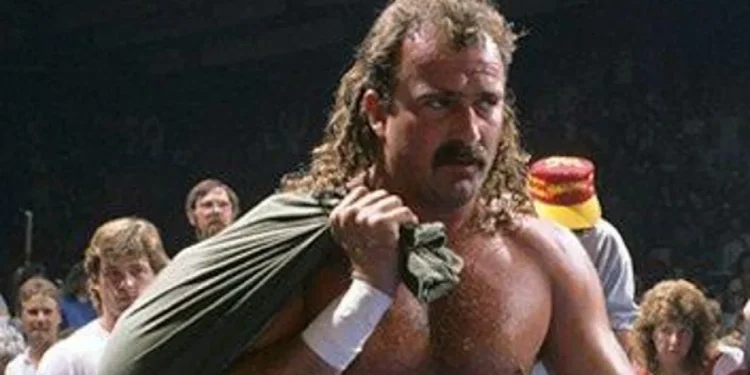After watching the 1999 documentary Beyond the Mat, you wouldn’t have bet on Jake “The Snake” Roberts living to see 50, considering the tragic fate of too many pro wrestlers.
If you’ve seen the documentary or are familiar with Jake’s numerous shoot interviews, you know that Aurelian Smith Sr., better known as Grizzly Smith, was not just a famed wrestler but also a father to Jake and fellow pro wrestlers Sam Houston and Rockin’ Robin. Unfortunately, he was also an abusive and neglectful father. An alcoholic who physically and mentally tormented his children, Grizzly told Jake he’d never succeed as a pro wrestler. Jake was determined to prove him wrong.
And prove him wrong he did. While most remember Jake from his WWF heyday in the late ’80s and ’90s, his rise began much earlier, closer to home. Before his WWF stardom, Jake made a name for himself in the Dallas, Texas promotion, World Class Championship Wrestling (WCCW), located just an hour south of his hometown of Gainesville and Whitesboro. By the time he joined WCCW, one of the most-watched wrestling territories outside the WWF, thanks to its broadcast on an international Christian network, Jake had already developed two of his signature elements: the Snake persona and the DDT.
Jake’s legendary DDT move is a tale often recounted, particularly by those who worked with Bill Watts. According to Jake, the move was born around 1983 or 1984 while he was in Watts’ Mid-South Wrestling (which later became the first UWF). During a match, Jake had Len Denton (aka the Grappler) in a front face lock and accidentally fell backward, driving Denton’s head into the mat. The DDT was born, and soon after, “D-D-T” became one of the first fan-initiated chants during WWF TV and pay-per-views.
Jake’s “Snake” persona, much like the Honky Tonk Man’s or the Crow version of Sting, was inspired by pop culture. He modeled his gimmick after Ken “The Snake” Stabler, the famed Oakland Raiders quarterback. Jake’s natural instincts for what makes a great wrestler led him to incorporate the slithering mannerisms and eventually carry a giant snake in a military canvas bag into the ring—an image forever associated with his character.
Combined with some of the best mic work in the business (ever hear another wrestler use “avarice” correctly in a promo?), Jake the Snake was a hot heel when he transitioned from Paul Ellering’s Legion of Doom stable in Mid-South to WCCW in 1984. He quickly aligned with WCCW’s top heel, Gino Hernandez, to battle the hometown heroes, the von Erichs, and fellow face Chris Adams.
In September 1984, during a match pitting Hernandez and Roberts against Adams and Kevin von Erich, Adams turned heel in one of WCCW’s most famous angles, joining forces with Roberts and Hernandez against his former friends, the von Erichs. This shocking turn of events in WCCW was as monumental as Hulk Hogan’s heel turn when he joined the nWo years later.
Jake went on to win the WCCW Television Title on his own and the 6-Man Tag Championship with Adams and Hernandez. Jake even pinned Kerry von Erich, WCCW’s biggest star, to secure the 6-man titles for his team. One can’t help but wonder how it must have felt for Aurelian Jr. to achieve such success in North Texas, so close to the childhood home where Aurelian Sr. had doubted and abused him.
Jake the Snake experienced his share of victories and losses in WCCW, but he consistently shared the ring with the promotion’s biggest stars—Adams, Hernandez, the von Erich brothers, Iceman Parsons, the Fabulous Freebirds, and Billy Jack Haynes—during the Star Wars Series, WCCW’s major shows before the pay-per-view era. On WCCW TV and at house shows, Roberts dominated opponents like Buck Zumhofe (another wrestler with a troubled past), Art Crews, Jules Strongbow (kayfabe brother of Chief Jay), George Weingeroff, Mike Gallagher, and Ricky Torres, suffering no losses. Zumhofe managed a single time-limit draw but lost every other encounter with the popular heel Roberts.
Jake also encountered the seedy underbelly of the wrestling world during his time in WCCW. He met and dated Missy Hyatt, who would later become a host and manager in Ted Turner’s World Championship Wrestling in the early ’90s and has since shared stories about her relationships with various wrestlers. In interviews, Jake has recounted the reckless lifestyles of the von Erichs—wild men with tragic endings (except for Kevin)—and confirmed the shady gang and drug elements surrounding Gino Hernandez’s untimely death. The Dallas wrestling scene undoubtedly fueled Jake’s own struggles with addiction.
Sensing, as many top talents did, that he would never surpass the von Erichs in their own promotion, Jake the Snake returned to Mid-South for most of 1985 before making the leap to the WWF in early 1986. There, Jake’s popularity soared to the point where the WWF had to cancel a planned rivalry between him and face champion Hulk Hogan, fearing Jake’s fan appeal might rival Hogan’s.
In the end, Jake the Snake Roberts became a bigger name in the wrestling business than his father could have ever imagined.



















































